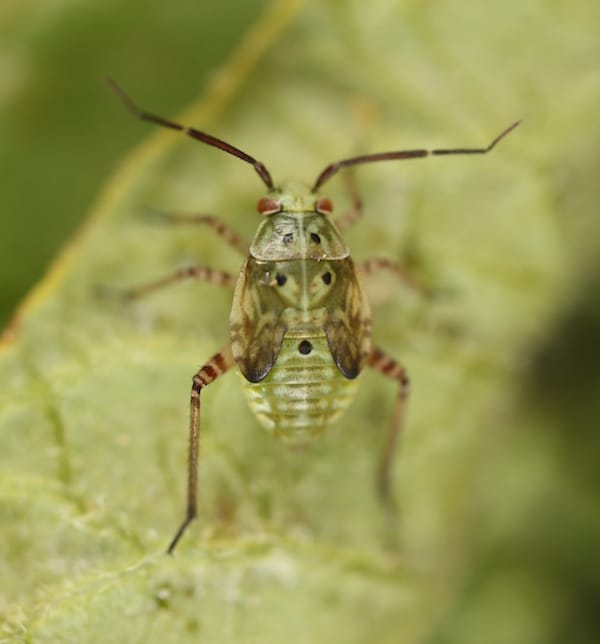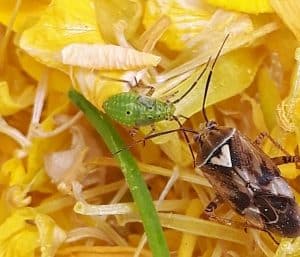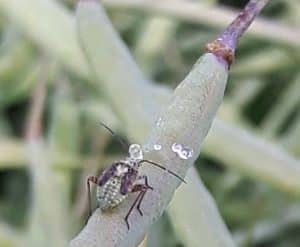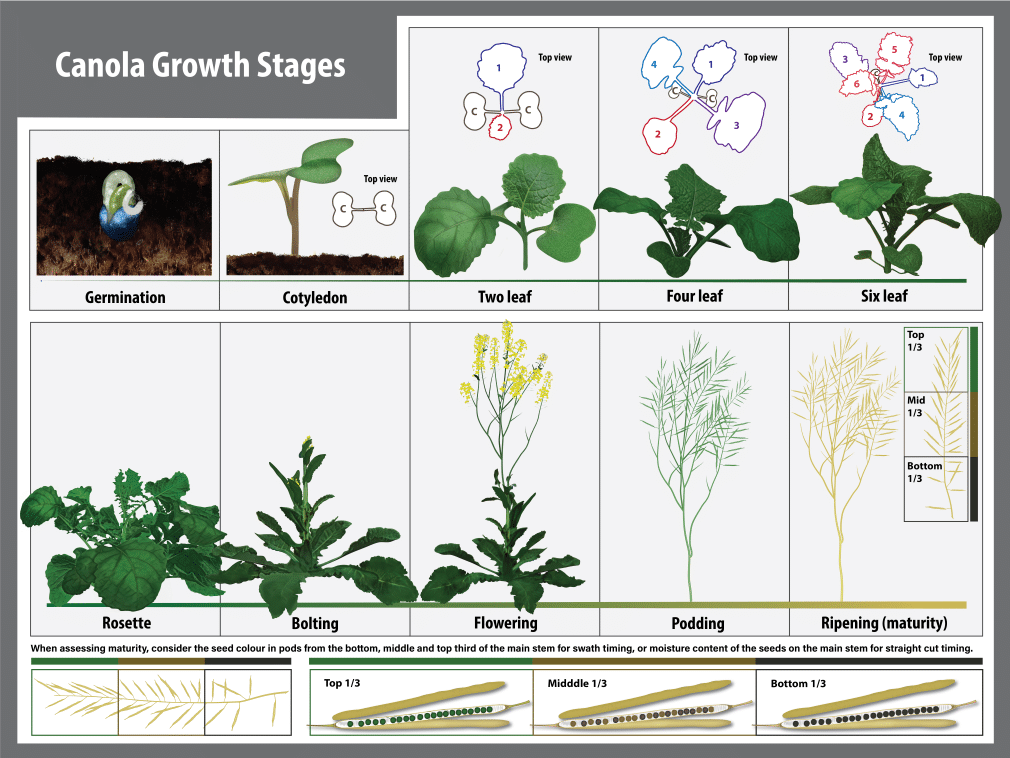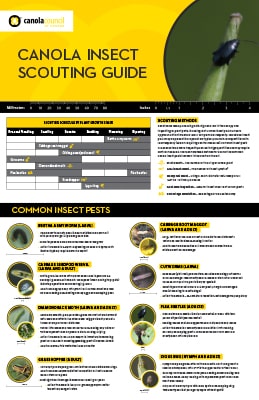Lygus bugs management in canola begins with sweep netting at late flowering and pod stages. Count adults and late instars. The standard threshold is 20-30 per 10 sweeps.
The most vulnerable crop stage for lygus feeding is after flowering and when seeds are enlarging on lower pods.
Scouting
Scout lygus at late flowering and podding stages using a standard insect sweep net of 38 cm (15″) diameter. Take ten 180° sweeps, and aim to sweep the flowers and pods while moving forward. In thick crops, take a couple of steps and stand while sweeping vigorously. If you are not seeing a few pods in the net, sweep harder. Count the number of big lygus in the net. Sweep net technique.
Count adults and late-instar nymphs
Nymphs are young lygus, and only the larger nymphs do enough damage to be included in sweep net counts. (See the images below.) A key feature is the black dots on the back. Count nymphs with developing wingpads or dark shoulder blades. Don’t count those nymphs without developing wings.
Small nymphs (without black dots) don’t feed very aggressively, and they are vulnerable to heavy rains and wind that push them down in the canopy or to the ground where they drown or other insects eat them. If you are seeing a lot of earlier nymphs, check again every few days. It may take as little as a week for lygus to grow from early to late instar stages. If swathing is a week away and most lygus are small nymphs, these are unlikely to be a threat before the crop is cut.
Increase accuracy with sweeps at multiple spots
Sampling is more representative when repeated at multiple spots within a field, notes the Prairie Pest Monitoring Network. For lygus bug monitoring, samples are most accurate when repeated at 15 spots within the field. Observations show that lygus populations are often evenly distributed across canola fields at podding. Multiple sweeping locations, times and dates increase the certainty of population assessment.
Recent studies confirmed that lygus DO NOT migrate into canola from cut alfalfa hay in the Prairies, although this had historically been considered as a risk factor. Lygus complete the first generation on weeds and native plants, and new adults migrate from there to flowering crops. These crops include canola, flax, faba bean and many others.

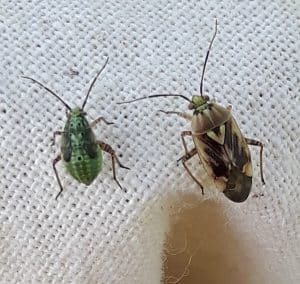
Lygus life cycle
In southern regions of the Prairies, most of the lygus feeding on canola at the pod stage are the offspring of adults that entered canola at the late bud and early flower stages. Long warm seasons in the south may allow for a third generation. Northern areas usually have just one pest generation – the overwintered adults.
Small nymphs can reach damaging size (third instar) in as little as seven to 10 days under warm dry conditions. Most of the potential damage occurs from the larger mouth parts of fourth and fifth instars and adults.
As seeds and pods harden, lygus will keep moving to progressively younger tissue. When only the youngest pods at the tips of canola racemes are soft, the threat from lygus is diminished as these late pods may not contribute significantly to yield.
Thresholds
- A threshold of 20-30 per 10 sweeps is suitable for good growing conditions.
- Agronomists in the Black Soil Zone of Alberta with good soil moisture have in the past considered 50-80 per 10 sweeps to be a more likely threshold.
Threshold tables developed from lygus research in the 1980s and 1990s were very specific about the estimated damage of each lygus bug in 10 sweeps relative to crop price and cost of control. That level of precision below one lygus per sweep is deemed inaccurate in light of new data from Agriculture and Agri-Food Canada lygus research in the recent years.
Research on the Validation of lygus and other insect pest thresholds in commercial farms throughout the Prairie Provinces indicates that lygus numbers below 10 per 10 sweeps (one per sweep) can, on occasion, actually increase yield in good growing conditions – likely through plant compensation for a small amount of feeding stress. Numbers below 10 per 10 sweeps are unlikely to affect yield even under dry conditions. Spraying below 10 per 10 sweeps as indicated on the older threshold charts would not be advised, regardless of canola price.
Thresholds in dry conditions
A lower threshold may be suitable for dry conditions. However, because drought restricts canola yield potential, consider the economics when spraying under the established threshold of 20-30 per 10 sweeps.
The lower end of the threshold (about 20 per 10 sweeps) may be appropriate for stressed canola with less ability to compensate for feeding.
Timing
Pods are the focus for crop protection
The most vulnerable crop stage for lygus feeding is after flowering and when seeds are enlarging on lower pods. (This would be around stage 5.1 – firm green seed at bottom of main stem.)
After sweep netting, look for sticky sap spots on pods, pedicels and stems before making the spray decision. Oozing on pods suggests active feeding. If sweep net counts exceed thresholds, but there is no evidence of pod damage, growers could decide to hold off on spraying. Alternatively, if evidence of feeding is present but sweep net counts are low, try sweeping again in another area or another time of day. Counts can depend on weather conditions in the sweep zone. Avoid windy and rainy conditions.
Bud and flower stages too early
Lygus thresholds for the bud and flower stages are not needed because economic loss is rare at these stages. Also, later lygus populations are not accurately predicted from early season sweep counts.
Research shows that low-level lygus feeding at flowering can actually stimulate yield. The rare situation where spraying may be warranted at flowering stages is if numbers are so high that large areas of the crop are not coming into flower at bolting because the buds are damaged or blasted.
Leathery pods too late
The threat generally ends when most pods become “leathery” and when seeds inside are firm. As outer pod tissue toughens up and seeds become firm to roll, lygus can no longer penetrate the pods or seeds with their mouthparts.
Other considerations
Rainfall. Rain improves crop growth, lowering the risk from lygus. A heavy rain at podding will also knock lygus to the ground, where ground beetles and other beneficial insects can eat them.
Pod damage concern. Research observations indicate that discrete holes from lygus feeding don’t compromise pod integrity significantly. The risk of pod shatter due to insects is higher following feeding by cabbage seedpod weevil (CSPW) and their feeding and exit hole damage, diamondback pod stripping or even late season flea beetle pod feeding. Lygus are less likely to cause pod shatter than these other insects.
Other pests present. If lygus are at or above thresholds and other pests, such as diamondback moth larvae, are also feeding on pods and are near thresholds, this combination improves the potential economic return from applying insecticides.
Lygus and cabbage seedpod weevil. According to recent research by AAFC in Alberta, cabbage seedpod weevil (CSPW) and lygus do not become pests in the same fields. Early planted fields with high CSPW have very low lygus populations. Thus, there is no economic return to spray for lygus at early flower in early seeded fields. Read more research on lygus and CSPW.
More…
- Bring the Canola Insect Scouting Guide with you when checking fields to help identify lygus and other insects that you find.
- PPMN lygus bug monitoring protocols
- Lygus chapter in the Canola Encyclopedia
- Lygus bug research in the Canola Research Hub
- What did we learn from the lygus apocalypse? Canola Digest article

